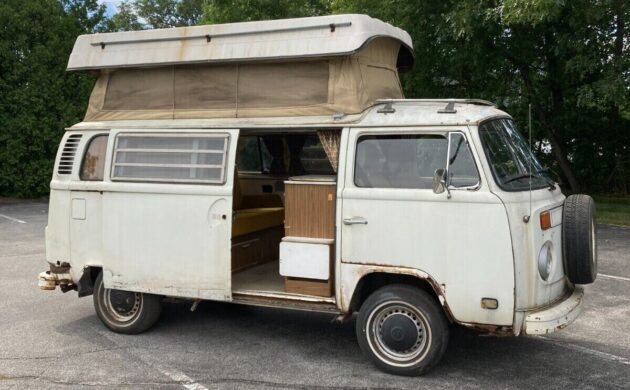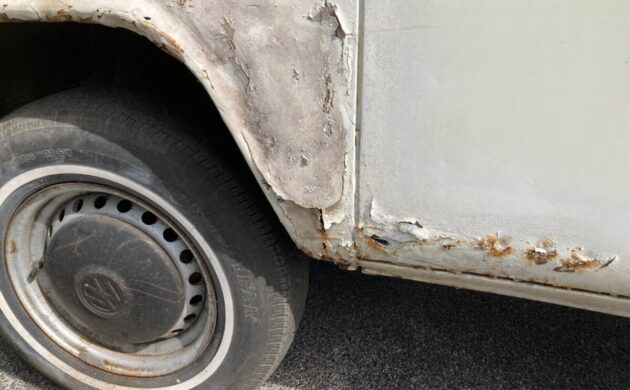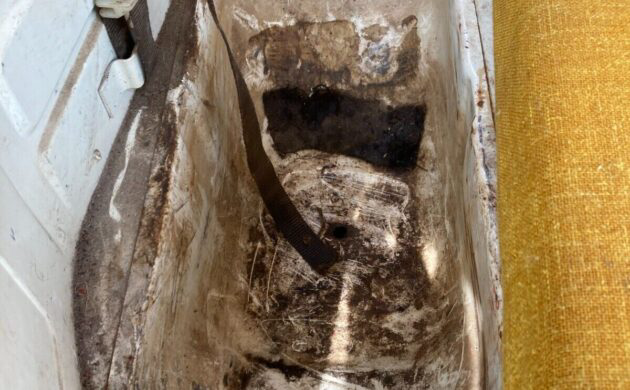Crudded-up Classic: 1973 Volkswagen Bus Camper
If you can’t say anything nice, don’t say anything at all. That was one of my grandmother’s favorite sayings, and it kinda applies to this 1973 Volkswagen Camper Van. The van waits in Dermotte, Indiana for its new owner to haul it away. You can be that person with the right bid here on eBay, where the price is $8100 after more than forty bids. But do it soon—the auction ends Tuesday afternoon, and in between now and then, you’ve got Independence Day to celebrate.
Why does that above saying apply? Because the seller’s description of this van compliments things like the condition of the cushions, the curtains, and the pop-up top but ignores most everything else, instead saying that if you want to know the problems, look at the pictures. One wonders why the seller can’t enumerate what’s wrong, but let’s look. Rust seems to have taken hold in the lower trailing edge of the front fenders, the leading edges of the doors, and the rear panel just ahead of the bumpers. And we’re not talking surface corrosion here, though the underneath has surface rust, as does the rear cargo area floor. The rust in the body is deep, the kind that makes metal crunchy and that you can break off by hand. So it really doesn’t matter that the car has an older, original-color repaint, does it? You’re gonna have to take the grinder to this monster.
Want more good news? The engine can’t be started—no key—a condition that may go back two decades. But the engine turns freely (though it has nearly 125K on the clock) and all four wheels move. Sounds kind of minimum standard, if this is the happiest things get here. Finally, while we’re on the pictures, there’s one that I can’t at all place, so let’s see what you say in the comments. It’s above here, and to me, it looks like some kind of gaping toothless clown face. Is that . . . ? Well—I can’t even supply a guess. I suppose that makes it very clear that I won’t be waving the bidder paddle on this one, but as someone with a love of and curiosity about mechanical objects, I still want to know not just what it is, but whether this is a good one of those, or a bad one. If it’s like most of the rest of what’s shown, it’s probably the latter.
But maybe you’re not as VW-dumb as I am, and you’d be inclined to bid (though checking around, I find lots of far better-looking similar-year Campers for way less than what this thing is going to cost to get into decent shape). What would you do with this if you had it? At some point, camp in it, but not until after a thorough de-crudding. Even if the sink and the fridge work, and I don’t know why a seller wouldn’t test those, though this one hasn’t, this still strikes me as a ten-foot-pole vehicle in terms of body integrity, interior order, and engine/mechanical bits.
Auctions Ending Soon
 2002 Subaru Impreza WRXBid Now2 days$333
2002 Subaru Impreza WRXBid Now2 days$333
 1975 Chevrolet Corvette ConvertibleBid Now2 days$4,000
1975 Chevrolet Corvette ConvertibleBid Now2 days$4,000
 1964 Ford F-100 Camper CustomBid Now2 days$2,000
1964 Ford F-100 Camper CustomBid Now2 days$2,000
 2006 Jeep Wrangler SportBid Now4 days$10,500
2006 Jeep Wrangler SportBid Now4 days$10,500
 1974 Datsun 260ZBid Now6 days$460
1974 Datsun 260ZBid Now6 days$460





Comments
So, you’re right, it certainly does look like a toothless clown face. I probably wouldn’t have noticed it if you hadn’t pointed it out, lol. I believe it is actually the spare tire storage area located in the left rear of the van next to the engine cover. The black piece (toothless gaping mouth) is an adhesive felt strip that kept the tire in place, there would have been one on the other side of the well also, but it appears to be missing. The strap would have kept the tire secure.
Got it Bluetec 320. As a former owner I have to say that the bidding up to this point is a whole lot more than I’d give for one of these in that condition. Nothing simple about welding panels in these rigs, if you can find the metal to do so.
Correct me if I’m wrong but in ’73 the fridge was an ice box. Our ’77 had the same fridge but it was on the left side. In the ’70s block ice wasn’t hard to find, not easily found today. Our ’84 was propane and electric.
Thanks for the feedback. I hope we’ve created a new way of seeing the spare tire storage area lol.
What a rust bucket. I always thought the front of these looked somewhat like a clown face. I’m not seeing it in that one picture though, although I never did fair too well on that Rorschach inkblot test lol.
Haha. Well said. I appreciate the comment!
Oh, by “Rorschach inkblot test” did you mean all those black and white images of butterflies? …..:)
With this kind of rust, the heater tube and control cables are long gone, not to mention the front floorboards. I’d have to pass.
Everyone seems to agree about the rust. Are these bidders all from somewhere where terminal rot is just a fact of life? I can’t imagine starting on this thing, even if I could weld.
These bidders see the older 21 window vans going for six figures, and have hope that they kind find the same kind of rich crazy people, who’ll plunk down serious cash for these model years.
Rust? What rust? all I see is hole where metal used to be….
AND..this is an odd bird. The interior is genuine Westfalia. Westfalia, for those who don’t know, was the official supplier of camper models to VW. VW would send un-completed vans to Westfaliawerk who would then install their “stuff” and ship them back. These campers would then be sent to VW dealers to be sold. All of the van, interior etc,would fall under the new car guarantee. From 1974 all the vans that were sent to Westfalia were built to BE campers with unique roof structures and so on. Earlier pop-top “Westies” were built on the sunroof van structure, minus the sliding panel, of course, THIS thing has a pop-top but it’s not a westfalia pop-top. I don’t recall if this is an American Sunroof Corp top or Riviera whatever, but it’s wrong for the interior. The choices here are that it was a standard van which someone put in the interior and top, Or, it could have been an aftermarket conversion where the interior was replaced with a Westfalia set up OR a non-poptop Westy onto which someone grafted the pop-top.
‘Who cares?” right? Well funny thing. To install that top, you have to CUT UP the roof and roof structure in the van, “Yeah..OK..and?” Well, it weakens the van structure a LOT. You don’t want to get into an accident in a VW van and the only thing that you had going for you was rollover protection, Cut the roof and that’s all gone. The van will fold up if rolled, The manufacturers of these units knew that and very often used subcontractors to do the installation work. Small time body shops and so on, WHEN there was a lawsuit, the shop, who didn’t have deep pockets, would get sued out of existence with the victims getting nothing. So I see a nice $500 parts car if the engine turns and the transmission isn’t too bad..Even repaired it is trash.
After looking more closely, it has the yellow-gold cloth interior which I have only seen used in the 73 Westfalia. So I’m going with “hardtop camper converted with an aftermarket roof”. That kinda kills the seller’s “ORIGINAL!” claims. Also,the fan shroud has the mounting boss for the AIR pump but nothing else, #1 if you’re planning on registering this in a state with emission inspections, that’s gunna be a issue. #2 The heads were modified for the AIR injector tubes to go into the exhaust ports and the loss of cooling air caused by this was supposed to be made up for by the cool air coming from the pump and blowing on the back of the exhaust valves. With that pump and plumbing missing, figure on a valve job every 3rd oil change..I know.”.if you can’t say anything nice…”.I’ll quit now…
I have a 1972 Westfalia SO-80 tintop Campmobile that had a Sportsmobile Penthouse fitted when new or nearly new. I visited Sportsmobile’s Indiana location with it many years ago and they said they had an installer in Maryland at the time the camper was originally sold new in Salisbury, so it may have been arranged by or through the original selling dealership.
The Sportsmobile Penthouse would have been considered an upgrade over the Westfalia poptop to many prior to the 1974 model year, because the early front-hinged Westy had a very narrow cot upstairs while the Penthouse had a wider twin-size bed. Mine is apart for restoration now, and I can tell you that the hole in the steel roof skin was cut without disturbing any of the factory roof crossmembers. Additionally, two lengthwise steel channels attached to the roof form the base of the robust scissor lift mechanism, so structural integrity isn’t compromised and might possibly have been enhanced by the conversion.
The Sportsmobile roof is a clever design, but their camper interiors were kinda cheesy. I’m certainly biased, but for me, the high-quality interior of a Westy tintop with a non-Westy camper top was the best of everything prior to 1974.
You don’t want to get in a collision in one these at all,one thing is for certain your the first one to the accident
That’s a Sportsmobile Penthouse. My Dad had one just like this. Same year and color but with destination stickers all over the side windows. This one has later seats with headrests and the seats would’ve been vinyl in the rear. Was kinda hoping this one was his. In ‘88 when we sold it, it was still in pretty nice shape, but that was long ago!